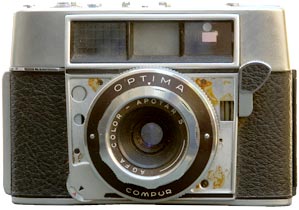
Approx. dates of manufacture: 1959
Approx. original price: $80
Approx. street value: low
I hesitate to add this because it's broken and will probably never be fixed. For a long time I thought it was missing pieces, but now I think all that's gone is the facia plate around the lens mount.
This is a very interesting camera. Early automatic cameras hooked up an on-board selenium light meter to the diaphram, and you got "auto exposure," because the camera controlled the aperture. A slightly more complicated camera allowed you to choose between a couple of shutter speeds, for which the meter would compensate. But what about a camera which could automatically set itself from a full range of both aperture and shutter speeds? That is a much tougher assignment.
s.jpg) In fact, it really didn't work until on-board computers showed up in the 1980s, and it became known as program mode.
In fact, it really didn't work until on-board computers showed up in the 1980s, and it became known as program mode.
But this camera does it electro-mechanically. You press down on that lever on the left side to make a reading, and when you're ready, you press the shutter button on the top with your right hand. The camera chooses both the aperture (between ƒ/3.9 and ƒ/22) and the shutter speed (between 1/30th and 1/250th).
So how does it do it?
According to the test results in Modern Photography magazine (Dec 1959), in the lower light conditions, the aperture remains at its widest position (ƒ/3.9) and the shutter speeds vary (according to the amount of light present) from 1/30 up to and including 1/250 sec. When the amount of light present exceeds the point where ƒ/3.9 and 1/250th would cause overexposure, then 1/250 sec shutter speed remains constant and the aperture closes down until 1/250 sec. and ƒ/22 is reached.
There's an under/over exposure warning flag in the viewfinder window.
Now here's the grain of salt (ibid): we used the Optima exclusively for outdoor shooting. Photographs made on black-and-white and color films (made in sunny, overcast and rainy days) indicated that the Optima will produce adequate exposures most of the time.
That's a ringing endorsement.
However (ibid): the Color Apotar S lens performed quite well. In normal shooting it produced negatives with which we made adequately sharp full frame 11x14 prints.
A drawback is that the lens only zone-focuses: close, middle and far. I suppose they did that because they didn't have a rangefinder and wanted to sell it to the mass market. But zone focusing is awful—you're better off just guessing the distance.
Camerapedia says today this system should be revived for environmental reasons since it needs no batteries. Yeah, maybe, but that selenium cell isn't exactly environmentally friendly. But it's an interesting idea nonetheless.
Modern Photography magazine camera test: Dec 1959
Camera manual: Orphan Cameras.com


